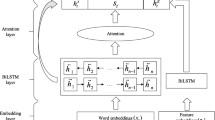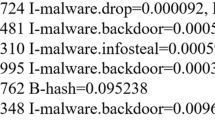Abstract
With the rapid development of Internet technology and the advent of the era of big data, more and more cyber security texts are provided on the Internet. These texts include not only security concepts, incidents, tools, guidelines, and policies, but also risk management approaches, best practices, assurances, technologies, and more. Through the integration of large-scale, heterogeneous, unstructured cyber security information, the identification and classification of cyber security entities can help handle cyber security issues. Due to the complexity and diversity of texts in the cyber security domain, it is difficult to identify security entities in the cyber security domain using the traditional named entity recognition (NER) methods. This paper describes various approaches and techniques for NER in this domain, including the rule-based approach, dictionary-based approach, and machine learning based approach, and discusses the problems faced by NER research in this domain, such as conjunction and disjunction, non-standardized naming convention, abbreviation, and massive nesting. Three future directions of NER in cyber security are proposed: (1) application of unsupervised or semi-supervised technology; (2) development of a more comprehensive cyber security ontology; (3) development of a more comprehensive deep learning model.
摘要
随着互联网技术飞速发展和大数据时代到来, 越来越多网络空间安全文本出现在互联网上. 这些文本不仅包括安全概念、 事件、 工具、 指南和政策, 还包括风险管理方法、 最佳实践、 保证和技术等. 整合大规模、 异构和非结构化的网络空间安全信息, 对网络空间安全实体进行识别和分类, 有助于处理和解决网络空间安全问题. 由于网络空间安全领域文本的复杂性和多样性, 使用传统的命名实体识别 (NER) 方法难以识别该领域中的安全实体. 本文介绍该领域NER的各种方法和技术, 包括基于规则的方法、 基于字典的方法和基于机器学习的方法, 并讨论该领域NER研究面临的问题, 如实体词组的结合与分离、 非标准化的命名约定、 缩写和大量嵌套等. 最后, 提出NER在网络空间安全方面的3个研究方向: (1) 应用无监督或半监督技术; (2) 开发更全面的网络空间安全本体; (3)应用更加有效的深度学习模型.
Similar content being viewed by others
Explore related subjects
Discover the latest articles and news from researchers in related subjects, suggested using machine learning.References
Bridges RA, Jones CL, Iannacone MD, et al., 2013. Automatic labeling for entity extraction in cyber security. https://arxiv.org/abs/1308.4941
Caruana R, 1997. Multitask learning. Mach Learn, 28(1):41–75. https://doi.org/10.1023/A:1007379606734
Devlin J, Chang MW, Lee K, 2018. BERT: pre-training of deep bidirectional transformers for language understanding. https://arxiv.org/abs/1810.04805
Dionísio N, Alves F, Ferreira PM, et al., 2019. Cyberthreat detection from Twitter using deep neural networks. Int Joint Conf on Neural Networks, p.1–8. https://doi.org/10.1109/IJCNN.2019.8852475
Eddy SR, 1996. Hidden Markov models. Curr Opin Struct Biol, 6(3):361–365. https://doi.org/10.1016/s0959-440X(96)80056-X
Gasmi H, Bouras A, Laval J, 2018. LSTM recurrent neural networks for cyber security named entity recognition. Proc 13th Int Conf on Software Engineering Advances, p.12–17.
Georgescu TM, Iancu B, Zurini M, 2019. Named-entity recognition-based automated system for diagnosing cybersecurity situations in IoT networks. Sensors, 19(15): 3380. https://doi.org/10.3390/s19153380
Gu XM, Liu JY, Cheng PS, et al., 2020. Malware name recognition in tweets based on enhanced BiLSTM-CRF model. Comput Sci, 47(2):245–250 (in Chinese). https://doi.org/10.11896/jsjkx.190500063
Hearst MA, Dumais ST, Osuna E, et al., 1998. Support vector machines. IEEE Intell Syst Their Appl, 13(4):18–28. https://doi.org/10.1109/5254.708428
Joshi A, Lal R, Finin T, et al., 2013. Extracting cybersecurity related linked data from text. Proc 7th Int Conf on Semantic Computing, p.252–259. https://doi.org/10.1109/ICSC.2013.50
Kaelbling LP, Littman ML, Moore AW, 1996. Reinforcement learning: a survey. J Artif Intell Res, 4:237–285. https://doi.org/10.1613/jair.301
Kim G, Lee C, Jo J, et al., 2020. Automatic extraction of named entities of cyber threats using a deep Bi-LSTM-CRF network. Int J Mach Learn Cyber, 11(10):2341–2355. https://doi.org/10.1007/s13042-020-01122-6
Lafferty JD, McCallum A, Pereira FCN, 2001. Conditional random fields: probabilistic models for segmenting and labeling sequence data. Proc 18th Int Conf on Machine Learning, p.282–289.
Lal R, 2013. Information Extraction of Security Related Entities and Concepts from Unstructured Text. MS Thesis, University of Maryland, Baltimore County, Baltimore, USA.
Lample G, Ballesteros M, Subramanian S, et al., 2016. Neural architectures for named entity recognition. https://arxiv.org/abs/1603.01360
LeCun Y, Bengio Y, Hinton G, 2015. Deep learning. Nature, 521(7553):436–444. https://doi.org/10.1038/nature14539
Lee JY, Dernoncourt F, Szolovits P, 2018. Transfer learning for named-entity recognition with neural networks. Proc 11th Int Conf on Language Resources and Evaluation, p.4471–4473.
Li T, Guo YB, Ju AK, 2019. A self-attention-based approach for named entity recognition in cybersecurity. Proc 15th Int Conf on Computational Intelligence and Security, p.147–150. https://doi.org/10.1109/CIS.2019.00039
Liu WG, 2020. Network security entity recognition methods based on the deep neural network. In: Huang CC, Chan YW, Yen N (Eds.), Data Processing Techniques and Applications for Cyber-Physical Systems. Springer, Singapore, p.1687–1692. https://doi.org/10.1007/978-981-15-1468-5_201
Long Z, Tan LZ, Zhou SP, et al., 2019. Collecting indicators of compromise from unstructured text of cybersecurity articles using neural-based sequence labelling. Int Joint Conf on Neural Networks, p.1–8. https://doi.org/10.1109/IJCNN.2019.8852142
Lowd D, Meek C, 2005. Adversarial learning. Proc 11th ACM SIGKDD Int Conf on Knowledge Discovery in Data Mining, p.641–647. https://doi.org/10.1145/1081870.1081950
Ma PC, Jiang B, Lu ZG, et al., 2021. Cybersecurity named entity recognition using bidirectional long short-term memory with conditional random fields. Tsinghua Sci Technol, 26(3):259–265. https://doi.org/10.26599/TST.2019.9010033
Marrero M, Urbano J, Sánchez-Cuadrado S, et al., 2013. Named entity recognition: fallacies, challenges and opportunities. Comput Stand Interf, 35(5):482–489. https://doi.org/10.1016/j.csi.2012.09.004
Mazharov I, Dobrov BV, 2018. Named entity recognition for information security domain. Proc 20th Int Conf on Data Analytics and Management in Data Intensive Domains, p.200–207.
McNeil N, Bridges RA, Iannacone MD, et al., 2013. PACE: pattern accurate computationally efficient bootstrapping for timely discovery of cyber-security concepts. Proc 12th Int Conf on Machine Learning and Applications, p.60–65. https://doi.org/10.1109/ICMLA.2013.106
Mendes PN, Jakob M, García-Silva A, et al., 2011. DBpedia spotlight: shedding light on the web of documents. Proc 7th Int Conf on Semantic Systems, p.1–8. https://doi.org/10.1145/2063518.2063519
Mulwad V, Li WJ, Joshi A, et al., 2011. Extracting information about security vulnerabilities from web text. IEEE/WIC/ACM Int Conf on Web Intelligence and Intelligent Agent Technology, p.257–260. https://doi.org/10.1109/WI-IAT.2011.26
Nadeau D, Sekine S, 2007. A survey of named entity recognition and classification. Lingv Investig, 30(1):3–26. https://doi.org/10.1075/li.30.1.03nad
Peters ME, Ammar W, Bhagavatula C, et al., 2017. Semi-supervised sequence tagging with bidirectional language models. https://arxiv.org/abs/1705.00108
Qin Y, Shen GW, Zhao WB, et al., 2019. A network security entity recognition method based on feature template and CNN-BiLSTM-CRF. Front Inform Technol Electron Eng, 20(6):872–884. https://doi.org/10.1631/FITEE.1800520
Riloff E, 1993. Automatically constructing a dictionary for information extraction tasks. Proc 11th National Conf on Artificial Intelligence, p.811–816.
Roy A, Park Y, Pan SH, 2017. Learning domain-specific word embeddings from sparse cybersecurity texts. https://arxiv.org/abs/1709.07470
Ruder S, 2016. An overview of gradient descent optimization algorithms. https://arxiv.org/abs/1609.04747
Shang HJ, Jiang R, Li AP, et al., 2017. A framework to construct knowledge base for cyber security. Proc IEEE 2nd Int Conf on Data Science in Cyberspace, p.242–248. https://doi.org/10.1109/DSC.2017.55
Shen YY, Yun H, Lipton ZC, et al., 2017. Deep active learning for named entity recognition. Proc 2nd Workshop on Representation Learning for NLP, p.252–256.
Simran K, Sriram S, Vinayakumar R, et al., 2020. Deep learning approach for intelligent named entity recognition of cyber security. https://arxiv.org/abs/2004.00502
Syed Z, 2010. Wikitology: a Novel Hybrid Knowledge Base Derived from Wikipedia. PhD Thesis, University of Maryland, Baltimore County, Baltimore, USA.
Syed Z, Padia A, Mathews ML, et al., 2016. UCO: a unified cybersecurity ontology. AAAI Workshop on Artificial Intelligence for Cyber Security, p.14–21.
Tikhomirov M, Loukachevitch N, Sirotina A, et al., 2020. Using BERT and augmentation in named entity recognition for cybersecurity domain. Proc 25th Int Conf on Applications of Natural Language to Information Systems, p.16–24. https://doi.org/10.1007/978-3-030-51310-8_2
Vaswani A, Shazeer N, Parmar N, et al., 2017. Attention is all you need. Proc 31st Int Conf on Neural Information Processing Systems, p.6000–6010.
Wang XR, Xiong ZH, Du XY, et al., 2020. NER in threat intelligence domain with TSFL. Proc 9th Int Conf on Natural Language Processing and Chinese Computing, p.157–169. https://doi.org/10.1007/978-3-030-60450-9_13
Weerawardhana S, Mukherjee S, Ray I, et al., 2014. Automated extraction of vulnerability information for home computer security. Proc 7th Int Symp on Foundations and Practice of Security, p.356–366. https://doi.org/10.1007/978-3-319-17040-4_24
Wu H, Li XY, Gao YL, 2020. An effective approach of named entity recognition for cyber threat intelligence. Proc IEEE 4th Information Technology, Networking, Electronic and Automation Control Conf, p.1370–1374. https://doi.org/10.1109/ITNEC48623.2020.9085102
Xiao ZF, 2018. Towards a two-phase unsupervised system for cybersecurity concepts extraction. Proc 13th Int Conf on Natural Computation, Fuzzy Systems and Knowledge Discovery, p.2161–2168. https://doi.org/10.1109/FSKD.2017.8393106
Zhang H, Guo YB, Li T, 2019. Multifeature named entity recognition in information security based on adversarial learning. Secur Commun Netw, 2019:6417407. https://doi.org/10.1155/2019/6417407
Zhou SP, Long Z, Tan LZ, et al., 2018. Automatic identification of indicators of compromise using neural-based sequence labelling. https://arxiv.org/abs/1810.10156
Author information
Authors and Affiliations
Contributions
Chen GAO designed the research and drafted the paper. Xuan ZHANG guided the research. Hui LIU collected the relevant materials. Mengting HAN helped organize the manuscript. Chen GAO and Xuan ZHANG revised and finalized the paper.
Corresponding author
Ethics declarations
Chen GAO, Xuan ZHANG, Mengting HAN, and Hui LIU declare that they have no conflict of interest.
Additional information
Project supported by the National Natural Science Foundation of China (Nos. 61862063, 61502413, and 61262025), the National Social Science Foundation of China (No. 18BJL104), the Natural Science Foundation of Key Laboratory of Software Engineering of Yunnan Province, China (No. 2020SE301), the Yunnan Science and Technology Major Project (Nos. 202002AE090010 and 202002AD080002-5), and the Data Driven Software Engineering Innovative Research Team Funding of Yunnan Province, China (No. 2017HC012)
Rights and permissions
About this article
Cite this article
Gao, C., Zhang, X., Han, M. et al. A review on cyber security named entity recognition. Front Inform Technol Electron Eng 22, 1153–1168 (2021). https://doi.org/10.1631/FITEE.2000286
Received:
Accepted:
Published:
Issue Date:
DOI: https://doi.org/10.1631/FITEE.2000286




